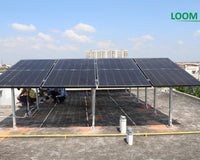Solar system installation has become increasingly popular in Jalandhar, Punjab. Many home and shop owners are installing solar systems to sustain their property and earn monetary benefits. In Jalandhar, you can install an on-grid solar system on most properties – including industrial and commercial.
What is an on-grid solar system in Jalandhar?
An on-grid solar system is a solar system that is connected to the city’s main power grid. The inverter installed in the system synchronizes the current from the solar PV modules as well as the grid’s current to provide the required power to the property.
During the day, the energy generated from the solar panel is used to power appliances. If the PV module generates excess current, it is offloaded to the grid. During the night, since the PV module is not generating any current, the grid’s connection is used to power appliances.
Residents opt for an on-grid system due to its easy installation and the subsidy provided by the state government for converting to solar.
What is the cost of an on-grid solar system in Jalandhar?
On-grid solar system installation costs in Solar system installation has become increasingly popular in Jalandhar Punjab. Many home and shop owners are installing solar systems to sustain their property and earn monetary benefits. In Jalandhar, you can install an on-grid solar system on most properties – including industrial and commercial.
What is an on-grid solar system in Jalandhar?
An on-grid solar system is a solar system that is connected to the city’s main power grid. The inverter installed in the system synchronizes the current from the solar PV modules as well as the grid’s current to provide the required power to the property.
During the day, the energy generated from the solar panel is used to power appliances. If the PV module generates excess current, it is offloaded to the grid. During the night, since the PV module is not generating any current, the grid’s connection is used to power appliances.
Residents opt for an on-grid system due to its easy installation and the subsidy provided by the state government for converting to solar.
What is the cost of an on-grid solar system in Jalandhar?
On-grid solar system installation costs in Solar system installation has become increasingly popular in Jalandhar, Punjab. Many home and shop owners are installing solar systems to sustain their property and earn monetary benefits. In Jalandhar, you can install an on-grid solar system on most properties – including industrial and commercial.
What is an on-grid solar system in Jalandhar?
An on-grid solar system is a solar system that is connected to the city’s main power grid. The inverter installed in the system synchronizes the current from the solar PV modules as well as the grid’s current to provide the required power to the property.
During the day, the energy generated from the solar panel is used to power appliances. If the PV module generates excess current, it is offloaded to the grid. During the night, since the PV module is not generating any current, the grid’s connection is used to power appliances.
Residents opt for an on-grid system due to its easy installation and the subsidy provided by the state government for converting to solar.
What is the cost of an on-grid solar system in Jalandhar?
On-grid solar system installation costs in Jalandhar vary from ₹7,000 to ₹70,000 depending upon the size of the system. Installation price can be understood from this table:
|
On-grid Solar System Size |
Installation Cost in Chennai |
|
Less than 1 kW |
Rs.3,000/- to Rs.6,000/- |
|
1 kW |
Rs.4,000/- to Rs.6,000/ |
|
2 kW |
Rs.5,000/- to Rs.8,000/- |
|
3 kW |
Rs.7,500/- to Rs.12,000/- |
|
4 kW |
Rs.10,000/- to Rs.16,000/- |
|
5 kW |
Rs.12,000/- to Rs.20,000/- |
|
More than 5 kW |
Rs.2.5/Watt to Rs.6/Watt |
Installation cost does not include the price of solar panels. The installer may also charge ₹500-1500 for additional wiring and maintenance.
What are the components of a grid-connected PV system?
The components of a grid-connected PV system include:
- Solar panel: Solar panel is the primary component required in a grid-connected PV system. The solar panel absorbs sunlight and converts the energy into a direct current (DC) that is provided by the system. Solar panel sizes and quantities vary depending upon the required system size.
- Inverter: The solar inverter converts the direct current (DC) generated by the solar panels into alternating current (AC). Common appliances such as fridges, air conditioners, TV, printer, PCs, laptops, etc., do not function on DC. They require AC to function and therefore, a solar inverter cannot be skipped.
- Solar wires: Two types of solar wires are required because the system connections run on two types of currents. The current generated by the solar panel and going to the inverter is DC, and for this connection, DC wires are required. From the inverter to the city’s main power grid or the property’s main lines, AC is used, therefore AC wires are required.
- Solar structure: The solar structure is also known as a mounting structure. This structure holds the solar panel at a specific angle and height to ensure maximum sunlight exposure. The size and height of the solar structure depends on both solar system size and property location.
- Distribution box: The AC distribution box (ACDB) and DC distribution box (DCDC) are added to prevent load failure. They are connected to the system to ensure the system does not overload and a short circuit is prevented.
- Export device controller: The export device controller can be installed if the property owner wishes to control how much current is fed back into the system. The controller allows a property owner to set a limit (from 0% to 100%) and that much energy is fed to the grid.
- Net meter: Net meter measures the amount of current fed to the grid during the day and the amount of current used during the night. The net meter provides two readings: current used and current given.
- Lightning arrester and Earthing: Lightning Arrester and Earthing are two safety measures installed with the solar panels. They are used as grounding to distribute excess energy into the ground. They distribute both: excess energy from the solar panel that cannot be used or fed into the grid, as well as the current from the lightning strike.
How much roof space is required to set up a grid-connected rooftop solar system?
A grid-connected rooftop solar system generally requires 10 square meters of shadow-free area. The area requirement may increase if the system is larger or if the solar panels have lower wattage. Other factors that can affect roof space requirements are the efficiency of solar panels, the number of modules, and solar structure and design.
What is net metering?
Net metering is an automatic electric billing mechanism used by electricity distribution companies (DISCOM) that measures the electricity used and fed by a solar system. The net metering system is installed with the solar system and shows two readings: current used and current given. If the difference between the two determines how much electricity bill the property owner will have to pay at the end of the month. Net metering monitors both readings accurately.
Which is best: on-grid or off-grid solar system?
- Have shadow-free, unused rooftop space that they want to use.
- Stable access to grid connection.
- Want to reduce their electricity bill.
Off-grid systems should be installed by property owners who:
- Do not have access to stable electricity supply.
- Live in rural areas with no power grid.
- Want to be independent of the power grid.
How much does a 5kW solar system cost in Jalandhar ?
The installation cost of a 5 kW solar system in Jalandhar is ₹25000. The benchmark cost set by the Ministry of New and Renewable Energy (MNRE) is ₹40,991 (for general states and UTs) and ₹45,087 (for Northeast states and UTs). However, this price may vary depending upon the solar structure selected, the age of the roof, location and other components selected.
What is the 1 kW Solar System Price in India?
The benchmark cost of a 1 kW solar system as set by the MNRE are as follows:
|
Location |
Price |
|
General category states and UTs |
₹46,923 |
|
Northeast states and UTs |
₹51,616 |
What is the Subsidy on Solar in Jalandhar?
Central financial assistance (CFA) or subsidy for Jalandhar is available only for residential sector grid-connected solar rooftop projects. CFA is as follows:
- 40% of benchmark cost or 40% of tender rates (whichever is lower) for capacity up to 3 kWp.
- 20% of benchmark cost or 20% of tender rates (whichever is lower) for capacity of 3 kWp to 10 kWp.
- 20% of benchmark cost or 20% of tender rates (whichever is lower) for the GHS/RWA category up to 500 kWp (limited to 10 kWp per house).vary from ₹7,000 to ₹70,000 depending upon the size of the system. Installation price can be understood from this table:












